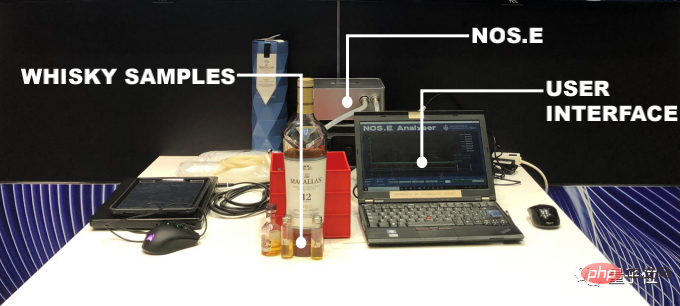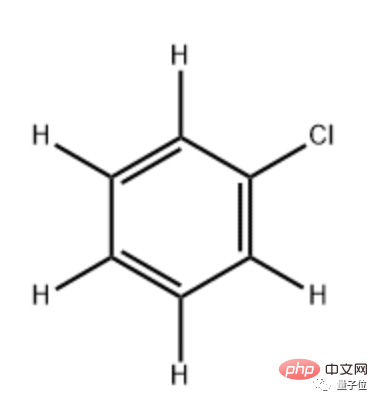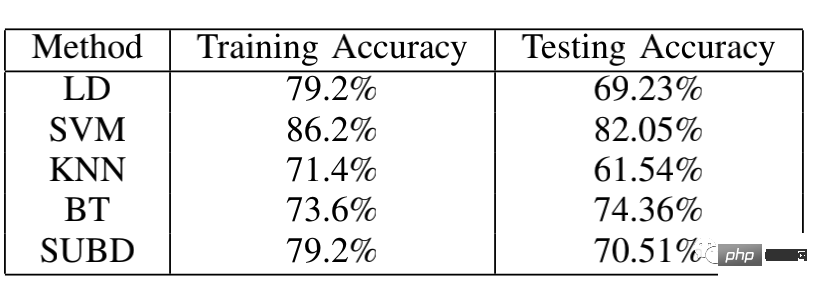 Technology peripherals
Technology peripherals
 AI
AI
 The 'electronic nose' has an accuracy rate of identifying whiskey as high as 96%. Netizens: Give one to Moutai too
The 'electronic nose' has an accuracy rate of identifying whiskey as high as 96%. Netizens: Give one to Moutai too
The 'electronic nose' has an accuracy rate of identifying whiskey as high as 96%. Netizens: Give one to Moutai too
Domestic Moutai and some high-end foreign whiskeys are expensive, but they are also important targets for counterfeiting.
How can ordinary people quickly determine the quality and authenticity of wine without a sommelier?
Recently, a group of engineers developed an "electronic nose" called NOS.E, which is specially used to smell wine.
It can "smell" different whiskey styles, brands and origins in less than 4 minutes, opening up new ideas for wine appreciation.
Why rely on "smell" instead of "taste"?
In fact, characteristics such as taste, smell, texture and color of whiskey can provide effective information for its evaluation.
Among them, smell is the main factor that affects the taste of wine. Researchers used this as the main breakthrough to design NOS.E.
At the 2019 Australian CEBIT trade show, they tested six whiskeys with NOS.E: among them, the regional accuracy rate was 100%, the brand name accuracy rate was 96.15%, and the style accuracy rate was 92.31 %.
Although it’s called an “electronic nose”, it doesn’t really look like a nose!

In April this year, the research paper was published in IEEE Sensors, a journal of IEEE.
After seeing this news, some netizens said excitedly: Finally, we can identify fake wine!

# Some netizens joked that one should be developed for Moutai.

So, how does this nifty and practical wine tasting tool work? Is it really reliable?
Sample pretreatment before testing
Previously at the CeBIT trade show, the developers of NOS.E tested the effect of this "electronic nose" on-site.
Before the formal test, in order to control variables and reduce the interference of irrelevant variables on the results, the researchers preprocessed the samples:
They selected 6 whiskey samples as experimental subjects: 3 3 blended malt whiskeys and 3 single malt whiskeys, and equal amounts of sample were placed in individual solid phase microextraction (SPME) vials.

Heat the samples to 30°C; and use SPME fiber to sample chlorobenzene-D5 as a reference for gas chromatography.

Then, each SPME fiber collected with chlorobenzene-D5 was placed on top of each whiskey sample (not in contact with the liquid) and left to stand for 5 minutes.
Next, these SPME fibers are put into the GC×GC-TOFMS instrument in sequence, and the collected information is processed and analyzed.
The electronic nose conducted 396 tests on 6 samples
In order to imitate the human olfactory system, the researchers equipped NOS.E with a total of 8 odor sensors.
The formal test begins——
Inject air into the SPME vial containing the sample to promote the volatile organic compounds in the wine to be discharged to the electronic nose faster.
In order to imitate the human olfactory system, researchers designed eight gas sensors for NOS.E.

The electronic nose evaluates each odor detected by the molecule and then feeds the data into a computer: the collected data is normalized, and non-parametric kernel modeling ( nonparametric kernel-based modeling) preprocessing.
The modeling process is carried out on MATLAB.
In order to reduce the impact of sensor deviation, the following normalization formula is adopted:

where, y(t) and ˆy(t) Represents the response of the sensor before and after normalization respectively.
Then, NOS.E’s system extracts 9 features from the response of the gas sensor: including the maximum first derivative of the sensor response, the minimum second derivative, the maximum second derivative, the time of input and response peak intervals etc.
After feature extraction, classify the data: randomly shuffle the data set of each whiskey, and then split it 80:20 to build a training set and a test set.
For the training set, use the ten-fold cross-validation (10-CV) method to divide it into 10 subsets to learn the whiskey classification model: 9 subsets are used for training, and the remaining 1 is used for verification.
Use linear discriminant (LD), support vector machine (SVM) and subspace discriminant (SUBD)* to train classifiers and generate a set of component classifiers for building new combined classifiers .
The final analysis results are sent to the terminal by the new classifier and presented to the user.

In order to reduce accidental errors, the researchers conducted multiple experiments on each whiskey sample; and after testing each sample 10 times, replaced it with a new one of the same kind. Whiskey to reduce the impact of alcohol evaporation on the experiment.
The researchers tested a total of 396 times before and after.
NOS.E performs well in determining the origin and style of whiskey
In order to test the accuracy of the data collected and processed by NOS.E, the researchers also used the most advanced two-dimensional gas chromatography -A whiskey sample was analyzed by time-of-flight mass spectrometry (GC×GC-ToFMS) as a control.
They tested the NOS.E test results in 3 dimensions.
The first aspect is: whether each whiskey sample can be separated from each other. The accuracy of NOS.E's on-site test results is as follows:

#The second aspect is: judging the origin of various whiskey samples, NOS.E's test results have the highest accuracy It actually reached 100%.

The third aspect is: judging the style of various whiskey samples. The accuracy of the NOS.E test results is about 82% to 94%.

About the author

Wentian Zhang, the first author of the research paper, is at Shandong First Medical University and Australia He teaches at the University of Technology Sydney; his main research directions are control engineering calculations and medical calculations.
Taoping Liu from Xi'an University of Electronic Science and Technology also participated in the development of NOS.E. He graduated with a PhD from the University of Technology, Sydney, Australia. His main research directions are control engineering calculations and medical calculations.
According to a report from the University of Technology Sydney, in addition to identifying whiskey, NOS.E may also be used to detect brandy and perfume in the future.
If this research can be promoted and applied, it may also be used for more alcoholic beverages in the near future. Consumers only need to use a small electronic product to easily determine the category and authenticity of a wine.
Well, by then, Chinese drinkers should no longer have to worry about buying fake Moutai~ (manual dog head)
Paper address: https://ieeexplore.ieee.org/ document/9701291
Reference link: [1]https://www.smithsonianmag.com/smart-news/a-new-electronic-nose-may-help-sniff-out-counterfeit-whiskey-180979931 /
[2]https://en.wikipedia.org/wiki/Gas_chromatography
The above is the detailed content of The 'electronic nose' has an accuracy rate of identifying whiskey as high as 96%. Netizens: Give one to Moutai too. For more information, please follow other related articles on the PHP Chinese website!

Hot AI Tools

Undresser.AI Undress
AI-powered app for creating realistic nude photos

AI Clothes Remover
Online AI tool for removing clothes from photos.

Undress AI Tool
Undress images for free

Clothoff.io
AI clothes remover

AI Hentai Generator
Generate AI Hentai for free.

Hot Article

Hot Tools

Notepad++7.3.1
Easy-to-use and free code editor

SublimeText3 Chinese version
Chinese version, very easy to use

Zend Studio 13.0.1
Powerful PHP integrated development environment

Dreamweaver CS6
Visual web development tools

SublimeText3 Mac version
God-level code editing software (SublimeText3)

Hot Topics
 1378
1378
 52
52
 What do you think of furmark? - How is furmark considered qualified?
Mar 19, 2024 am 09:25 AM
What do you think of furmark? - How is furmark considered qualified?
Mar 19, 2024 am 09:25 AM
What do you think of furmark? 1. Set the "Run Mode" and "Display Mode" in the main interface, and also adjust the "Test Mode" and click the "Start" button. 2. After waiting for a while, you will see the test results, including various parameters of the graphics card. How is furmark qualified? 1. Use a furmark baking machine and check the results for about half an hour. It basically hovers around 85 degrees, with a peak value of 87 degrees and room temperature of 19 degrees. Large chassis, 5 chassis fan ports, two on the front, two on the top, and one on the rear, but only one fan is installed. All accessories are not overclocked. 2. Under normal circumstances, the normal temperature of the graphics card should be between "30-85℃". 3. Even in summer when the ambient temperature is too high, the normal temperature is "50-85℃
 Join a new Xianxia adventure! 'Zhu Xian 2' 'Wuwei Test' pre-download is now available
Apr 22, 2024 pm 12:50 PM
Join a new Xianxia adventure! 'Zhu Xian 2' 'Wuwei Test' pre-download is now available
Apr 22, 2024 pm 12:50 PM
The "Inaction Test" of the new fantasy fairy MMORPG "Zhu Xian 2" will be launched on April 23. What kind of new fairy adventure story will happen in Zhu Xian Continent thousands of years after the original work? The Six Realm Immortal World, a full-time immortal academy, a free immortal life, and all kinds of fun in the immortal world are waiting for the immortal friends to explore in person! The "Wuwei Test" pre-download is now open. Fairy friends can go to the official website to download. You cannot log in to the game server before the server is launched. The activation code can be used after the pre-download and installation is completed. "Zhu Xian 2" "Inaction Test" opening hours: April 23 10:00 - May 6 23:59 The new fairy adventure chapter of the orthodox sequel to Zhu Xian "Zhu Xian 2" is based on the "Zhu Xian" novel as a blueprint. Based on the world view of the original work, the game background is set
 Database testing skills in Golang
Aug 10, 2023 pm 02:51 PM
Database testing skills in Golang
Aug 10, 2023 pm 02:51 PM
Database testing skills in Golang Introduction: Database testing is a very important link when developing applications. Appropriate testing methods can help us discover potential problems and ensure the correctness of database operations. This article will introduce some common database testing techniques in Golang and provide corresponding code examples. 1. Testing using an in-memory database When writing database-related tests, we usually face a question: How to test without relying on an external database? Here we can use memory
 How to use MTR to conduct reliability testing of MySQL database?
Jul 13, 2023 pm 12:05 PM
How to use MTR to conduct reliability testing of MySQL database?
Jul 13, 2023 pm 12:05 PM
How to use MTR to conduct reliability testing of MySQL database? Overview: MTR (MySQL Test Runner) is a testing tool officially provided by MySQL, which can help developers conduct functional and performance testing of MySQL databases. During the development process, in order to ensure the reliability and stability of the database, we often need to conduct various tests, and MTR provides a simple, convenient and reliable method to conduct these tests. Steps: Install MySQL test runner: First, you need to download it from the MySQL official website
 The new king of domestic FPS! 'Operation Delta' Battlefield Exceeds Expectations
Mar 07, 2024 am 09:37 AM
The new king of domestic FPS! 'Operation Delta' Battlefield Exceeds Expectations
Mar 07, 2024 am 09:37 AM
"Operation Delta" will launch a large-scale PC test called "Codename: ZERO" today (March 7). Last weekend, this game held an offline flash mob experience event in Shanghai, and 17173 was also fortunate to be invited to participate. This test is only more than four months away from the last time, which makes us curious, what new highlights and surprises will "Operation Delta" bring in such a short period of time? More than four months ago, I experienced "Operation Delta" in an offline tasting session and the first beta version. At that time, the game only opened the "Dangerous Action" mode. However, Operation Delta was already impressive for its time. In the context of major manufacturers flocking to the mobile game market, such an FPS that is comparable to international standards
 How to use Selenium for automated web testing
Aug 02, 2023 pm 07:43 PM
How to use Selenium for automated web testing
Aug 02, 2023 pm 07:43 PM
Overview of How to Use Selenium for Web Automation Testing: Web automation testing is a vital part of the modern software development process. Selenium is a powerful automated testing tool that can simulate user operations in a web browser and implement automated testing processes. This article will introduce how to use Selenium for web automation testing, and come with code examples to help readers get started quickly. Environment preparation Before starting, you need to install the Selenium library and web browser driver
 What are the differences between function testing and coverage in different languages?
Apr 27, 2024 am 11:30 AM
What are the differences between function testing and coverage in different languages?
Apr 27, 2024 am 11:30 AM
Functional testing verifies function functionality through black-box and white-box testing, while code coverage measures the portion of code covered by test cases. Different languages (such as Python and Java) have different testing frameworks, coverage tools and features. Practical cases show how to use Python's Unittest and Coverage and Java's JUnit and JaCoCo for function testing and coverage evaluation.
 How to disable test cases in Maven?
Feb 26, 2024 am 09:57 AM
How to disable test cases in Maven?
Feb 26, 2024 am 09:57 AM
Maven is an open source project management tool that is commonly used for tasks such as construction, dependency management, and document release of Java projects. When using Maven for project build, sometimes we want to ignore the testing phase when executing commands such as mvnpackage, which will improve the build speed in some cases, especially when a prototype or test environment needs to be built quickly. This article will detail how to ignore the testing phase in Maven, with specific code examples. Why you should ignore testing During project development, it is often



